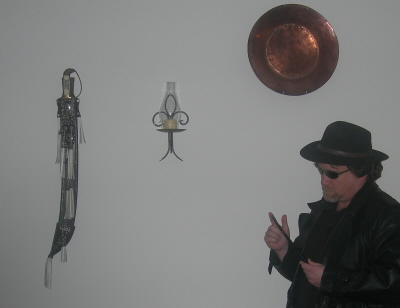|
About This Author
Come closer.
|
Carrion Luggage #1094669 added August 4, 2025 at 9:38am
Restrictions: None
Put On a Happy Face
It's everywhere. In my phone. On my computer. Hell, I'm looking at one right now, just above this word. A three-year-old article from The Hustle:
The $ 500m smiley face business 
Nearly 50 years ago, one man ‘invented’ the modern smiley face. Then, another man halfway across the world made it into a multimillion-dollar cash cow.
Ah, yes, capitalism: where you take someone's emotions and sell them back to them at a profit.
This simple icon — a yellow circle, two dots, a smile — retained relevancy through 50 years of cultural movements, from free love to raves to the digital revolution.
My favorite iteration was in Alan Moore and Dave Gibbons's Watchmen. 
And in the process, it became a family-owned global licensing empire worth more than $500m per year. But how did it get there?
$500m isn't a lot for a global business, but it's a lot from every other perspective.
In 1963, a Worcester, Massachusetts-based freelance artist named Harvey Ball received a life-changing call from a local client.
So, given the article is from 2022, it was closer to 60 years than 50.
State Mutual Life Assurance Company had just merged with an out-of-town competitor, and employee morale was waning. They needed some kind of quirky and fun design to lift spirits around the office.
These days, they'd lay off half the staff and hold a pizza party for the survivors.
It soon became clear that Ball’s simple illustration was worth millions of dollars. But he’d made a critical mistake: He never filed a trademark.
Whoops. Yeah, that's almost as bad as how Siegel and Shuster got stiffed for creating a certain Kryptonian.
On the flip side, artists sketch stuff every day, and the vast, vast majority fade into obscurity. It takes real luck to think "I'd better go through the process of securing my rights to this thing," when you'd presumably rather go on to the next drawing.
Halfway across the world, in Paris, France, a young journalist named Franklin Loufrani had his own stroke of invention.
Hang on a minute while I process the cognitive dissonance of a smiley face in Paris.
His creation, a smiling yellow face, bore a striking resemblance to Ball’s.
But unlike Ball, he foresaw the symbol’s marketing potential and immediately secured a French trademark.
The accompanying illustration of the front page of the newspaper in which it appeared. For some reason, one of the headlines is censored in it. The words under the smiley translate to "Take the time to smile."
“You could say there was a political or social meaning behind what he did, but it was really a commercial act,” Loufrani’s son, Nicolas, told The Hustle. “He wanted to make money on it.”
Dammit, France, you're supposed to be the socialist one and we're supposed to be the capitalist one.
In the early ‘70s, France was emerging from a counter-cultural movement similar to America’s hippie uprising: Students were rejecting moral strictures, embracing free love, and leaning into a sexual revolution.
How this is different from just "being France," I have no idea.
In the 1980s and early ‘90s, the smiley was adopted by a new generation of ecstasy-fueled ravers.
Somehow, I missed out on that particular cultural trend. It was mostly people younger than me. Hippies were mostly people older than me. You know what I got? Fucking disco.
By 1996, the smiley business wasn’t looking so hot. Licensing deals were down, and the logo was starting to lose its edge.
Oh no, a trend was ending.
Nicolas formed The Smiley Company and secured trademarks for the ‘smiley’ brand name in 100 countries around the world. In countries where it was taken, the Loufranis bought it, or battled the owner in court (including a famous, 10-year legal battle with Walmart in the US).
The link to the "legal battle" seems to be broken, but I did a quick search, ignoring AI as usual. Seems Wal-Mart effectively won that battle—and then proceeded to abandon the smiley face from its promotions anyway.
Then, against the wishes of his father, Nicolas made major updates to the old-school smiley face, morphing it from a static image to a 3D orb. He dubbed it the “new smiley.”
“It was totally against all marketing theory: If you have a logo, you don’t create new ones,” he says. “My father was furious. He said, ‘It’s stupid what you’re doing! You have a trademark! Keep the logo, but don’t change it!’”
Okay, I admit I'm far from an expert in marketing, but it seems to me that companies change their logos all the freakin' time. With a few notable exceptions, like Sherwin-Williams.
“When emojis started to pick up, we were seen as the originator, and it gave us a renewed credibility,” says Nicolas. “The smiley was cool again.”
Poop emoji grins in agreement.
Lots more at the link, of course. The story, however, failed to make me happy. Maybe if went back to Paris... |
© Copyright 2025 Waltz Invictus (UN: cathartes02 at Writing.Com). All rights reserved.
Waltz Invictus has granted InkSpot.Com, its affiliates and its syndicates non-exclusive rights to display this work. |

